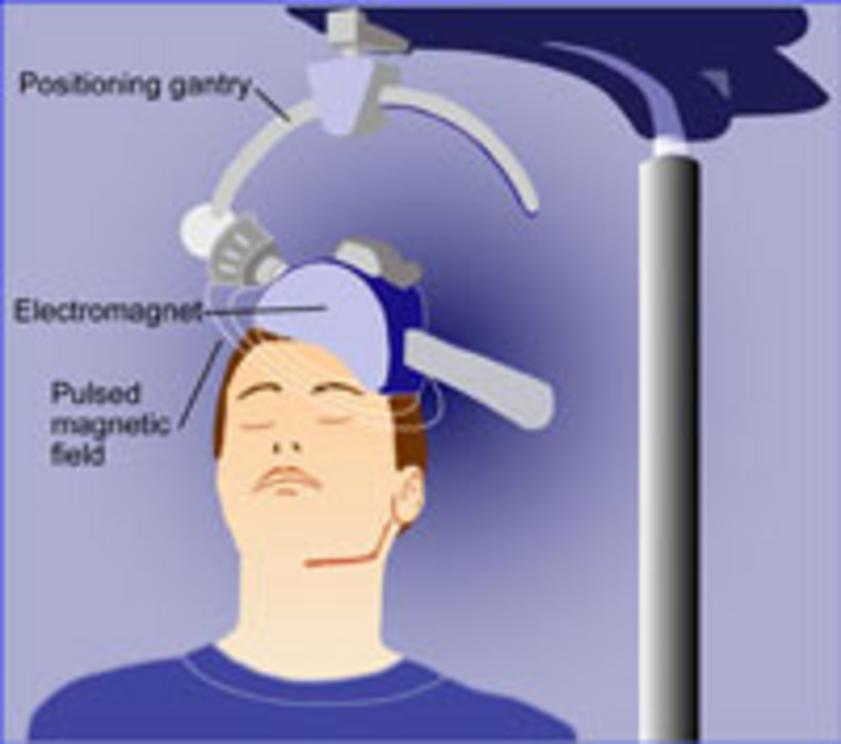We did transcranial magnetic stimulation for my son with autism
... and this is what happened
I have been following the results of individualized transcranial magnetic stimulation (iTMS) and similar treatments for quite some time. I knew I wanted to try it for my son Harry, but I wanted to wait until I felt that he would receive the most benefit from it. So, we cleaned up his gut and his detox pathways and dealt with bacteria, viruses, and parasites. We have used many modalities of treatment—Western medicine, biomedical approaches, homeopathy, herbals, and all kinds of alternative treatments—but I have felt a pull to do iTMS for a long time. During the month of October, we finally jumped in the deep-end.
We decided to use iSynchrony in Oakton, Virginia, which is just outside Washington DC. We did the treatment every weekday for five weeks total because that is the length of time I could reasonably commit to being far away from home. Each session lasts somewhere between 20 minutes and an hour, depending on a host of variables. You commit to a trial period first—somewhere between a week and two weeks—and then can decide to commit to the rest of the treatment period, depending on results.
What is iTMS, you ask?
Well, it is basically a big powerful magnet that is pulsed on different areas of your head to help the brain in different ways.
“Help” how, you ask?
From their website:
Using a well-established technology, the electroencephalogram (EEG), we analyze our patients’ brain wave activity to identify the areas that are “out of sync.” With this data, we create a customized plan to treat psychiatric and neurological disorders utilizing individualized Transcranial Magnetic Stimulation (iTMS).
iSynchrony’s Dr. Bob Silvetz has a tremendous amount of experience in treating the brain, and his list of credentials is impressive.
iTMS is used in a number of conditions: depression, opioid addiction, chemo brain, PTSD, anxiety, stroke-related motor planning, dementia, insomnia, and yes, autism. The general idea is that your brain is like an orchestra—this is how it was explained to me—and, in autism, the conductor is out to lunch, so the string section isn’t playing. The magnet is pulsed, and it attempts to tell neurons hanging out elsewhere to get to the place the magnet is asking them to go. You can find all the technical details on their website, but I’ll tell you about how we experienced it.
To give the reader a baseline, we started on this journey before Harry was two, when he was diagnosed with severe nonverbal autism with an ATEC of around 115. At the start of iTMS, his ATEC was in the high 20s. Our most significant problem at present is apraxia, a speech planning disorder. He has gained some language in the last 18 months, and he has kept the gains. He is limited to mostly one word at a time though, and lots of letter sounds are hard for him, especially v, j, n, f and z. We do not have many behavior problems at this point, but he is extremely fearful of haircuts and EEGs—well, anything on his head. He is okay with our dog, but fearful of other dogs. He is easy to be around and does not bolt or elope. He presents as severe ADHD with little focus, and we get a lot of “unavailable to learn”-type comments.
Day One:
We went into the office, filled out some forms, and consulted with Dr. Bob. Dr. Bob watched Harry—they have a room with a crash pad that Harry really liked—and made some initial observations. We went through an extensive health history. Then we went in to do an EEG. Harry HATES EEGs (and haircuts), but this one wasn’t so bad. It is super state-of-the-art and looks like an old-time padded hockey helmet with little nodules on it. No gel, no glue, no mess, and very little trauma. They only need about four minutes of calm and still to get the data they need. We got maybe 10 seconds of actual stillness on day one, but it was enough to get a baseline reading at least and enough to determine where we should start to place the magnets.
Dr. Bob took us into a conference room and showed us some slides of a “normal” brain and normal brain activity. Harry’s EEG showed virtually no frontal-lobe activity. He was basically walking around in a “sleep state” all day. This was crushing to me after all the work we’ve done, but it made a lot of sense too.
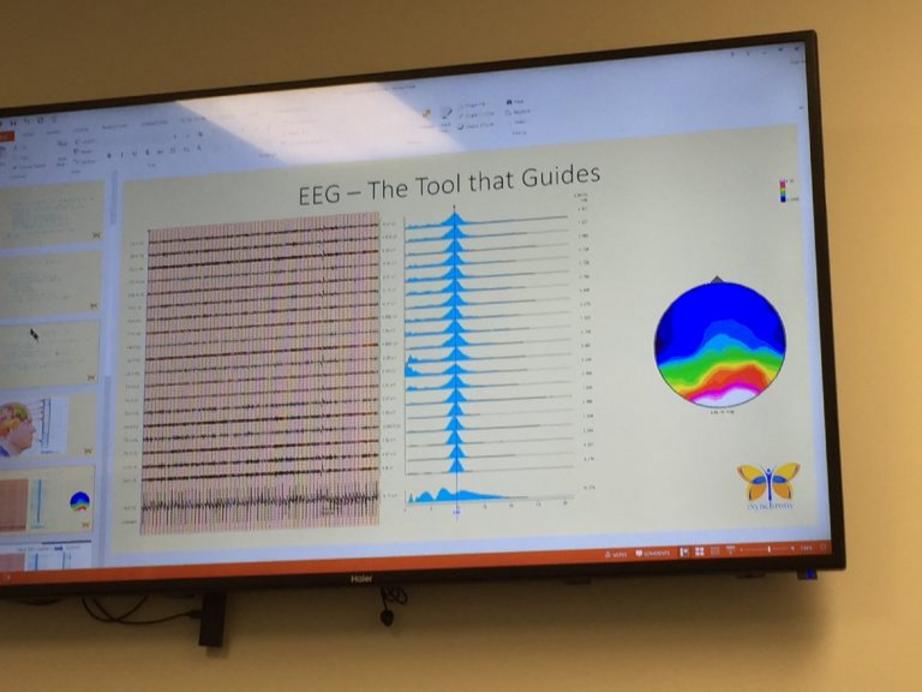 Neurotypical brain scan
Neurotypical brain scan
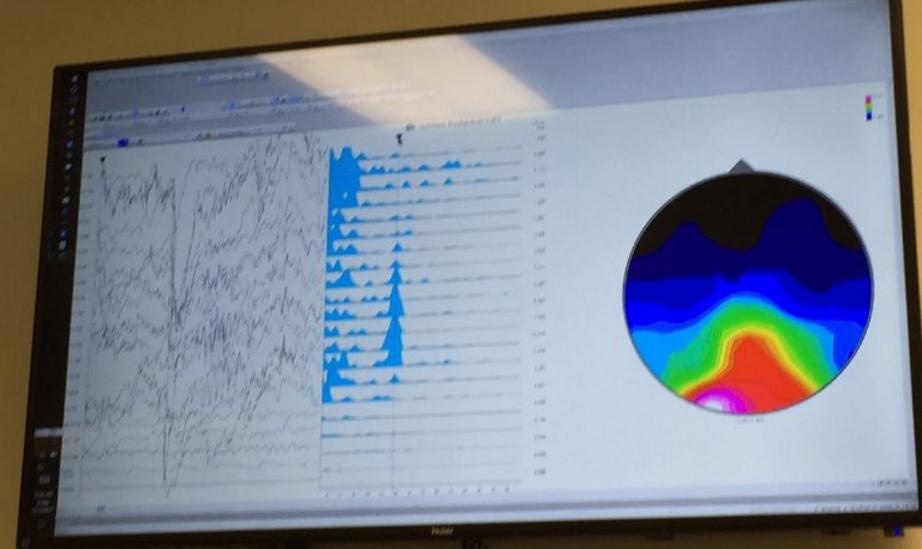 Harry’s initial brain scan
Harry’s initial brain scan
One cool thing we found out that day—the typical range for alpha-wave frequency in humans is 8.5–10.5. Harry’s was 13. Who else processes that fast? Olympic athletes and the entire Chinese ping-pong team. So, all we need to do is recover him from autism and we’ll have a professional athlete who can see the stitches of a baseball when it’s thrown at him at 100 mph. But, you know, no pressure.
We decided to place the magnet on his forehead, where we wanted more brain activity. He was uneasy the first day, but he must have liked it because he let us do the entire session. The session is broken down into the number of trains—how many times the magnet pulses—the time in between the trains, the length of the train, the frequency, and the strength. It’s part science, part art as far as I can tell.
After the first session, we went to Whole Foods and shopped. In the checkout line, I asked him to help me unload the cart. The week before, at home in Florida, I unloaded an item hand-over-hand with him, then he wandered away and lost interest. That day he unloaded the whole cart for me without assistance.
Weeks One and Two:
We continued for two weeks and did another EEG. I knew there would be a change on the EEG because we were seeing small changes: a few words here and there, and increased imitation. The EEG indeed showed activity in the frontal lobe. He was more amenable to the EEG as well.
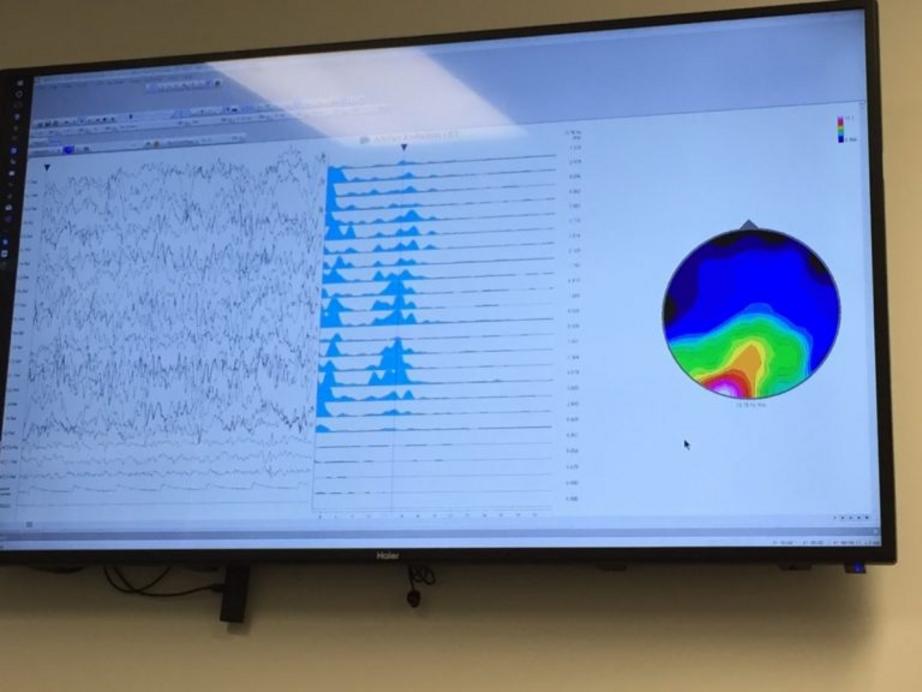 Harry’s scan after two weeks of iTMS
Harry’s scan after two weeks of iTMS
We decided we had seen enough from the trial period (which as I said can be anywhere from a week to two weeks, but in our case was the full two weeks) to continue treatment for the next three weeks. That weekend my husband and my other two kids flew up to DC, and they noticed a few changes. At the zoo my daughter followed an elephant footprint trail for a quarter of a mile or so. Harry watched her—and walked it to the end, stepping carefully on each footprint. He watched the elephants feed intently—almost like he was seeing them for the first time. And later, in front of the Washington monument, he watched my daughter roll sideways down a hill. He paused, then tried it, belly laughed, and kept rolling. We had never seen him do that before.
Week Three:
I was really frustrated. I felt like we didn’t see a whole lot. I felt very stuck—like I had completed the two-week trial period, paid more money, and then someone pressed the pause button. Dr. Bob was very understanding. He ran an additional EEG and showed me on paper that we were making progress even though it wasn’t yet translating into material gains. So, we kept going. But we made some adjustments. We moved the magnet to the side of his head where the speech center was. Dr. Bob had tried this in week two, but Harry did not cooperate. We decided we would split the sessions, placing the magnet on his forehead half the session and for the other half-session on the side of his head, just over the ear.
Week Four:
Week four was nothing short of a miracle. Harry started sleeping better. We were staying in a friend’s guest room, sharing a queen-size bed. Every time I woke up to use the restroom in the first three weeks, he flew out of bed. Dr. Bob had explained that even though he was a good sleeper, he wasn’t getting deep REM sleep. During week four he slept like a log and didn’t wake up when I did. Tuesday of that week I woke him up and he looked at me and said, “back sleepy.” By the end of the week, he was saying, “back to sleep.” He also answered his first spontaneous question. My friend asked him, “How was your day?”, and he reported “good” without prompting. We never had that before. He was able to repeat a lot more. He could also hear differences in language for what seemed like the first time. He had been able to say most of the alphabet before we went, but said the sounds rather than the letter names. I would say AY, BEE, SEE, DEE, and he would say AH, BUH, CUH, DUH like he could not hear the difference. That changed week four, and he started reciting it the way most people do. He began counting out loud too. I was doing homeschool-based lessons on the iPad, as I had pulled him from school for five weeks to do the treatment. He focused for two straight hours every day that week and often demanded more reading or math. He kept doing the lessons even when I stopped. Focus was very visibly improving. He was requesting “magnets” every morning. We also had him around a number of dogs and, though he had to warm up to each one individually, he did so quickly.
We had more gains. Harry loves the car wash, but it needs to be the kind you drive through while you are inside the car. He requested “car wash,” and I was sandwiched in a single-file line before I realized the car wash was one where we had to exit our vehicle. I explained to him that we needed to get out but that we could watch the car being washed through a window inside the building. Before the treatment this would have ended with me begging the management to let us sit in the car to avoid a meltdown. Instead, Harry looked at me, weighed the information, and decided to take a chance. And he loved the opposite view—watching the cars from the outside.
He followed directions better and really responded to reasoning at a new level too. He wasn’t triggering so quickly. He fell in love with the Natural History Museum and made me take him four times. Oh, and we are big on narwhals now. We also went into a bookstore in DC where he found books he loved as a baby—Goodnight Moon, and some Sandra Boynton books—and he read each word to me. Lots of word fragments and approximations, but the intent was the same.
Week Five:
Those gains continued into week five. We decided to double up the sessions in our last week—spacing the two sessions three hours apart each day. That week we heard clearer phrases (“our house,” “Kim’s pool,” “go jump”), clearer words in general, got the F sound (he could finally bite his lip to do it), and he managed to say the letter W (“double you”) instead of the sound. And then Thursday I decided to see if there were less concrete gains as well. When I mentioned that Harry hates haircuts, I was not kidding. It usually takes my husband holding his arms and torso and my 11-year-old son holding his legs to get a cut completed. It’s rough, and we all end up in tears.
I walked him into a kiddie-cut place. He sat in my lap and refused the cape, but he didn’t move. I did not hold his hands or restrain him in any way. He watched the stylist in the mirror with interest and didn’t flinch when she cut around his ears. This is such a big thing for him, I was bursting with pride. So was Harry.
The Final Day:
We went in and did the last EEG. Harry sat still for the full four minutes without complaint. He even managed to follow directions and kept his eyes closed the entire time. It showed a lot of progress, but there is still more to go. Dr. Bob thought it would be a slow burn—meaning we kick started Harry’s brain and it would continue to make progress after we came home. Dr. Bob still thinks he isn’t getting deep REM sleep.
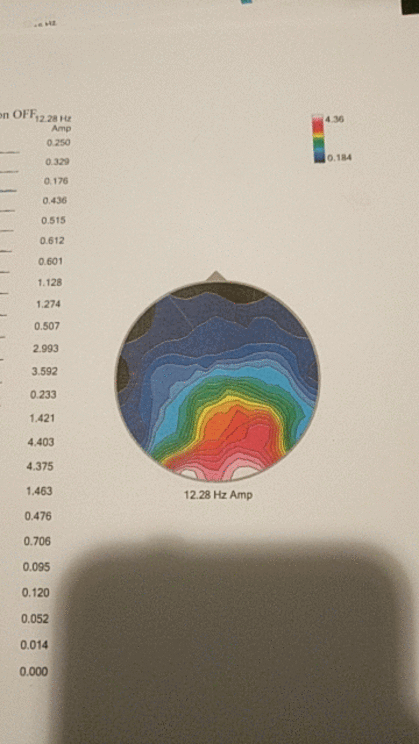 Harry’s final brain scan
Harry’s final brain scan
We have been home a little over a week. Reports from school indicate more focus and more words and word attempts. He attempts to repeat everything you ask. He is reading short books aloud (he could read before, but we only knew because of multiple-choice comprehension questions on the iPad). He wrote a few sentences this week.
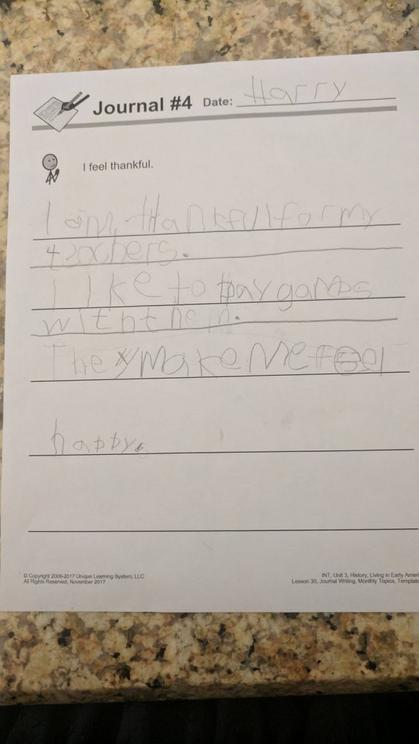
He was pretty flexible before, but this weekend when we were running errands he was able to verbally communicate that he was “all done” and wanted to “go home.” He got his wish.
I am excited to see the gains continue and would like to go back for another three months. But, you know, life and money, right? We will get there.
There are people who think this intervention opens the blood–brain barrier. We kept that in mind and were careful to limit toxins. We kept the same organic, GFCFSF, grain-free diet, used Fiji water exclusively (the high silica content binds to aluminum and helps it exit from the brain), and used an EMF-blocking pillow. I kept his supplements the same during treatment.
In all, I feel this was the right intervention at the right time. I would (and I will) do it again, and I feel like we gained and grew a tremendous amount in a very short period of time. It was a very successful treatment. For anyone considering it, I would advise the following: Before you do this, make sure the detox pathways are open. Drain and detox first, get the gut in good shape, then do this.
I know so many veteran warrior moms who have brought their kiddos so, so far but have not yet crossed the finish line to recovery. If you’ve stalled or plateaued, this might be the kick start you need. Research this treatment. Dr. Bob and his wife, Lorraine, were great to talk with and very patiently answered all my questions. They will help with finding affordable accommodations if needed. Weigh the cost vs. the possible gains in such a short time period, and if you feel called, go for it!
iSynchrony has generously offered TMR readers a very special discount. If five readers are treated during the same time period concurrently (airb&b a house share, guys!), they will offer a group discount and each person will get an incredible 50% off their treatment fee (limited time offer). What could be more fun than doing treatment with your autism BFFs?
P.S. – I was not compensated to write this. This is our experience only and is not to be construed as medical advice. XO

